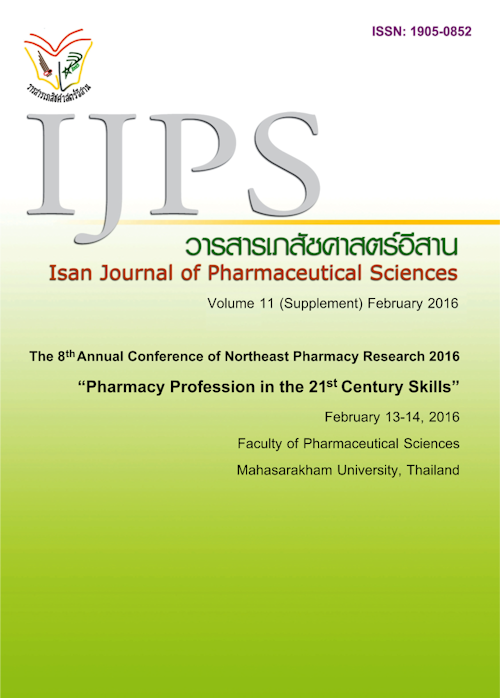Musculoskeletal Adverse Events Associated with Simvastatin Drug Interactions and Physician Response to Pharmacist Interventions
Main Article Content
Abstract
Introduction: Myopathy is the major adverse events which can be found with statins use. The statin-drug interaction is one of the important risk factor associated with musculoskeletal adverse events. Although simvastatin is mostly prescribed in Thailand, studies investigating the prevalence of musculoskeletal adverse events associated with simvastatin drug interactions is still limited. Objective: This study aims to investigate the prevalence of musculoskeletal adverse effect which is associated with simvastatin-drug interactions. In addition, we evaluated the physician response to pharmacist intervention regarding to potential simvastatin-drug interaction. Methods: Outpatients who had prescriptions containing potential simvastatin-drug interaction were recruited. This cross-sectional study was conducted between October 1, 2013 and February 28, 2014 at Piboonmungsaharn Hospital, Ubonratchathanee Province. The musculoskeletal adverse events were evaluated by using symptom checklist questionnaires and measuring plasma creatinine kinase (CK). The causal relationship between the adverse events and the potential simvastatin-drug interactions was assessed using the Drug Interaction Probability Scale (DIPS). Results: The potential simvastatin-drug interactions were found in 49 patients. Of these, we found 31 patients (63.3%) had myopathy. Myalgia was the most frequently identified adverse events (58.1%), followed by asymptomatic raising CK (25.8%), and myositis (16.1%). Musculoskeletal adverse events associated with simvastatin-drug interactions were found in 16 patients (51.6%). Of these, we found 50.0%, 31.3% and 18.8% had asymptomatic raising CK, myalgia, and myositis, respectively. The precipitant drugs associated with myopathy that mostly prescribed with simvastatin were gemfibrozil, colchicine and amlodipine. According to pharmacist interventions to physicians about simvastatin-drug interactions, the acceptance rate was 83.7% and the prescriptions were changed in 49.0%. Conclusion: Musculoskeletal adverse events with simvastatin use were found in Thai patients, and approximately half of them was associated simvastatin-drug interactions. Data suggested that the systems can be utilized by healthcare professionals are needed to increase awareness of potential simvastatin-drug interactions.
Article Details
In the case that some parts are used by others The author must Confirm that obtaining permission to use some of the original authors. And must attach evidence That the permission has been included
References
Armitage J. The safety of statins in clinical practice. Lancet 2007; 370(9601): 1781-90.
Backman JT, Kyrklund C, Kivisto KT, et al. Plasma concentrations of active simvastatin acid are increased by gemfibrozil. Clin Pharmacol Ther 2000; 68(2): 122-9.
Bellosta S, Corsini A. Statin drug interactions and related adverse reactions. Expert Opin Drug Saf 2012; 11(6): 933-46.
Boonmuang P, Nathisuwan S, Chaiyakunapruk N, et al. Characterization of statin-associated myopathy case reports in Thailand using the health product vigilance center database. Drug Saf 2013.
Bruckert E, Hayem G, Dejager S, et al. Mild to moderate muscular symptoms with high-dosage statin therapy in hyperlipidemic patients-the PRIMO study. Cardiovasc Drugs Ther 2005; 19(6): 403-14.
Chatzizisis YS, Koskinas KC, Misirli G, et al. Risk factors and drug interactions predisposing to statin-induced myopathy: implications for risk assessment, prevention and treatment. Drug Saf 2010; 33(3): 171-87.
Corsini A. Statin-related muscle complaints: an underestimated risk. Cardiovasc Drugs Ther 2005; 19(6): 379-81.
Cziraky MJ, Willey VJ, McKenney JM, et al. Statin safety: an assessment using an administrative claims database. Am J Cardiol 2006; 97(8A): 61C-8C.
Enger C, Gately R, Ming EE, et al. Pharmacoepidemiology safety study of fibrate and statin concomitant therapy. Am J Cardiol 2010; 106(11): 1594-601.
Furberg CD, Pitt B. Withdrawal of cerivastatin from the world market. Curr Control Trials Cardiovasc Med 2001; 2(5): 205-7.
Graham DJ, Staffa JA, Shatin D, et al. Incidence of hospitalized rhabdomyolysis in patients treated with lipid-lowering drugs. JAMA 2004; 292(21): 2585-90.
Horn JR, Hansten PD, Chan LN. Proposal for a new tool to evaluate drug interaction cases. Ann Pharmacother 2007; 41(4): 674-80.
Hu M, Mak VW, Tomlinson B. Simvastatin-induced myopathy, the role of interaction with diltiazem and genetic predisposition. J Clin Pharm Ther 2011; 36(3): 419-25.
Kashani A, Phillips CO, Foody JM, et al. Risks associated with statin therapy: a systematic overview of randomized clinical trials. Circulation 2006; 114(25): 2788-97.
Kuncl RW, Duncan G, Watson D, et al. Colchicine myopathy and neuropathy. N Engl J Med 1987; 316(25): 1562-8.
Law M, Rudnicka AR. Statin safety: a systematic review. Am J Cardiol 2006; 97(8A): 52C-60C.
Neuvonen PJ, Niemi M, Backman JT. Drug interactions with lipid-lowering drugs: mechanisms and clinical relevance. ClinPharmacolTher 2006; 80(6): 565-81.
Niel E, Scherrmann JM. Colchicine today. Joint Bone Spine 2006; 73(6): 672-8.
Nishio S, Watanabe H, Kosuge K, et al. Interaction between amlodipine and simvastatin in patients with hypercholesterolemia and hypertension. Hypertens Res 2005; 28(3): 223-7.
Sathasivam S. Statin induced myotoxicity. Eur J Intern Med 2012; 23(4): 317-24.
Shitara Y, Sugiyama Y. Pharmacokinetic and pharmacodynamic alterations of 3-hydroxy-3-methylglutaryl coenzyme A (HMG-CoA) reductase inhibitors: drug-drug interactions and interindividual differences in transporter and metabolic enzyme functions. Pharmacol Ther 2006; 112(1): 71-105.
Son H, Lee D, Lim LA, et al. Development of a pharmacokinetic interaction model for co-administration of simvastatin andamlodipine. Drug Metab Pharmacokinet 2014; 29(2): 120-8.
Staffa JA, Chang J, Green L. Cerivastatin and reports of fatal rhabdomyolysis. N Engl J Med 2002; 346(7): 539-40.
Stone NJ, Robinson J, Lichtenstein AH, et al. 2013 ACC/AHA Guideline on the Treatment of Blood Cholesterol to Reduce Atherosclerotic Cardiovascular Risk in Adults: A Report of the American College of Cardiology/American Heart Association Task Force on Practice Guidelines. Circulation 2013.
Tatro DS. Drug interaction facts. Missouri: Wolters Kluwer Health; 2011: 860-86.
Tirkkonen T, Ryynanen A, Vahlberg T, et al. Frequency and clinical relevance of drug interactions with lovastatin and simvastatin: an observational database study. Drug Saf 2008; 31(3): 231-40.
USFDA. FDA Drug Safety Communication: New restrictions, contraindications, and dose limitations for Zocor (simvastatin) to reduce the risk of muscle injury [Online]. 2011 [Cited 2013 Jan 11]. Available from: http://www.fda.gov/Drugs/DrugSafety/ucm256581.htm.
Watkins JL, Atkinson BJ, Pagliaro LC. Rhabdomyolysis in a Prostate Cancer Patient Taking Ketoconazole and Simvastatin: Case Report and Review of the Literature. Ann Pharmacother 2011; 45(2): e9.


